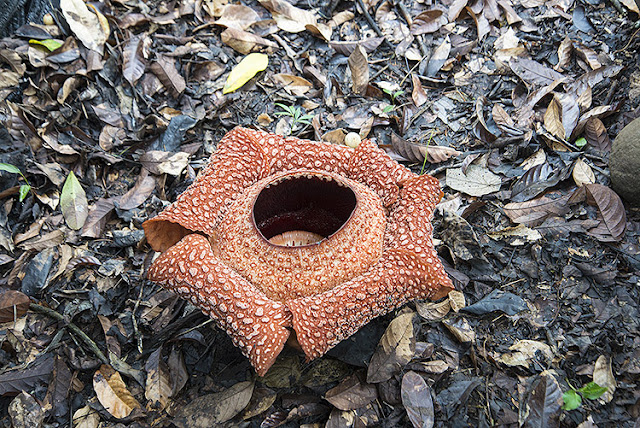The
Natural History of Sabah, Borneo
When I was around 9 or 10 I was given an encyclopaedia
of nature for Christmas. It contained a photograph of a Malaysian man, wearing
a traditional hat, sitting next to an enormous orange plant – the largest
flower in the world. Ever since, I have wanted to visit Borneo where the photo
was taken, and finally got the chance a few weeks ago.
One of our main
aims was to see carnivorous pitcher plants in the wild, on the slope up the
mountain. Unfortunately the path up was shut due to the earthquake, so we were
taken to an alternative site near Kinabalu golf club, apparently the highest in
the world. After a very strenuous climb (involving machetes) through dense jungle (when several members of
the party turned back) we arrived at the spot, and were shown Nepenthes rajah, the largest of the
pitcher plants. It was extraordinary to see them growing in the wild, and a
real privilege. Just as we finished photographing them it started to rain, and
when it rains in Borneo, it rains!! Our journey down became hazardous with mud
which turned into a highly slippery surface – I fell a couple of times and got caked in thick, orange mud.
Rafflesia keithii. A pristine flower, three days old, approximately 50cm across.
Bornean Pygmy Elephant
Proboscis Monkey
We saw plenty of wild Orangs (much better than the rather
disappointing Sepilok Centre) as well as other monkeys including Silvered Leaf
and Red Leaf Monkeys.
Red Leaf Monkey
The rainforest was drier than expected (it is an El Nino year)
but we still saw a great array of frogs, snakes lizards and insects, my own
favourite being the huge Three Horned Rhinoceros Beetle.
Three Horned Rhinoceros Beetle
Throughout the trip we used a variety of photographic
techniques, including long lens work from boats, long exposures of fireflies at
night, ultraviolet images of scorpions, time lapse cloud scenes and high speed
photography of seeds spiralling down from trees.
Fireflies at night. A 30 second exposure from the bank of the river, from a wooden platform provided by the guides from the lodge.
Large scorpion fluorescing in ultraviolet light at night in the Danum Valley
A tiny bat, roosting in a rolled up banana leaf. It became an obsession to check every leaf for bats!
Dipterocarp seeds spiralling down from tree
Seed of Alsomitra, one of the largest winged seeds in the wold, spiralling down from the canopy
A Dead Leaf Mantis - showing extraordinary camouflage
A Bornean Horned Frog
Oriental Dwarf Kingfisher
Lantern Bug
Mossy Tree Frog
Long Crested Forest Dragon
Short Crested Forest Dragon
Wagler's Pit Viper - a beautiful snake, which we saw on several occasions
Gomantong Cave, a major source of nest of Cave Swiftlets used in Birds Nest Soup. A hopefully subtle HDR image, composed of three separate images.
My trip was organised by Wildlife Worldwide, and led by
the brilliant Nick Garbutt, whose knowledge of the natural history of Borneo is
second to none, and whose animal wrangling skills led to some great images
(though don’t mention Atlas Moths !). For more details other trips organised by Wildlife Worldwide and Nick, see: http://www.wildlifeworldwide.com/discover/holiday-types/photography-tours-nick-garbutt


















































